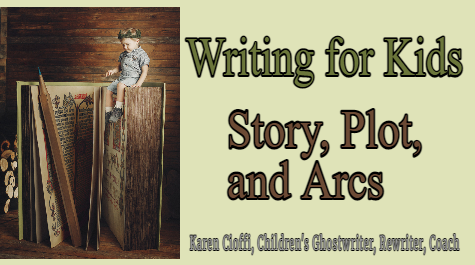Lately, I’ve received a few picture book manuscripts from potential clients who wanted quotes on editing.
Once I read over the stories, I quickly knew they weren’t editing projects because there were no actual stories. They were a list of events or scenes.
It seems to be a common problem with new authors who don’t take the time to learn the very basics of writing a story.
So, what exactly is a story and plot?
An article at The Write Practice uses a quote from E. M. Forster to explain the difference between story and plot: “The king died and then the queen died,” is a series of events and can be considered a story. “The king died, and then the queen died of grief” is a plot.
The story is the basic storyline. It’s the overall description of the story.
In my chapter book, Walking Through Walls, the storyline is that the protagonist wants to become rich and powerful, no matter what it takes.
The plot is in the details.
The plot of Walking Through Walls is that the protagonist wants to become rich and powerful, no matter what it takes, and he believes learning magic will get him there.
Another good example of story and plot is The Story of an Hour by Kate Chopin.
The story: Within one hour, the protagonist thinks her husband died in a train crash. Having missed the train, he comes home, and the protagonist drops dead.
The plot: The protagonist thinks her husband died in a train crash. Having missed the train, he comes home, and the protagonist drops dead, but it’s not from the shock of overwhelming joy.
Paints quite a different story, doesn’t it?
Now, if you have a series of events: Pickles the dog plays with a cat, then plays with a frog, then plays with a goat, then plays with a pig, you don’t have a story arc or character development. Again, this is a series of events.
I’ll have clients ask why something like the above isn’t a story. The dog is having lots of fun with different animals.
Well, if it was a concept book teaching about animals, then it could work.
But if it’s to be a fiction story, it doesn’t work. The reason is it lacks a story arc and a character arc.
The story arc is the path the overall story takes. Every character in the story goes on this journey.
It’s also called the narrative arc.
According to a MasterClass article, the narrative arc “provides a backbone by providing a clear beginning, middle, and end of the story.”
The character arc, on the other hand, is the path the protagonist takes.
Just like the story, this arc takes the protagonist on a journey along with the reader.
The character arc is all about the protagonist. It’s him confronting a conflict or challenge, his attempts to overcome it, and his ultimate success. Through this character journey, the protagonist grows in some way. She may gain knowledge, become confident, rise to challenges, mature, or grow in some other way. But it’s essential there is growth, especially when writing for children.
So, going back to Pickles the dog, he, as the protagonist, has no conflict or challenge to overcome. He doesn’t grow in any way.
And as for the Pickles story, it’s flat. There’s no arc.
Readers won’t become invested in a series of events. They want to connect to the protagonist and root for him to overcome his obstacles. They want a full story arc and character arc.
Summing It Up
Readers want to become immersed in a story. In order to achieve this, your story must have all the needed elements, including story and character arcs.

Whether you need help with ghostwriting or rewriting, or coaching, let me take a look at your children’s story, outline, or notes. You can contact me at: kcioffiventrice@gmail.com. Or give me a call at 347—834—6700. (Please leave a message- I’ll get back to you as soon as I can.)
OTHER HELP I OFFER:
HOW TO WRITE A CHILDREN’S FICTION BOOK
A DIY book to help you write your own children’s book.
FICTION WRITING FOR CHILDREN eCOURSE
4-Weeks / 8 Sections Guided Self-Study Mentoring Program

7 Steps to Writing Success Through Positive Thinking
Writing Elements – Is One More Important Than Another?
Submitting Your Ghostwritten Book to a Children’s Publisher


6 thoughts on “Story, Plot, and Arcs”